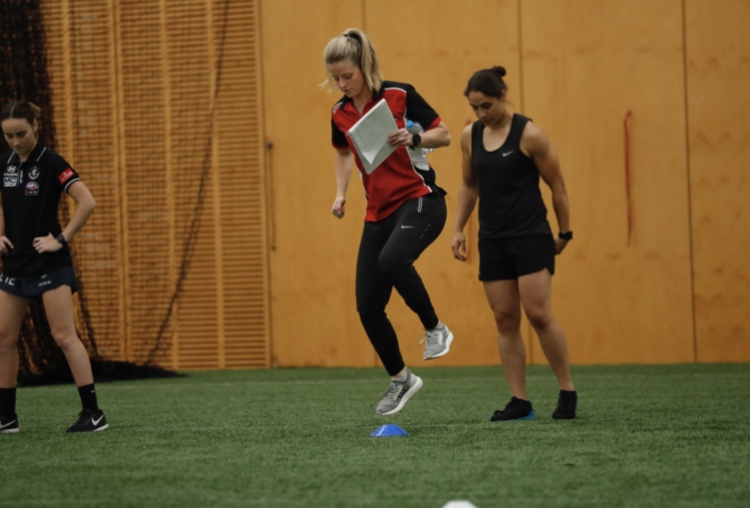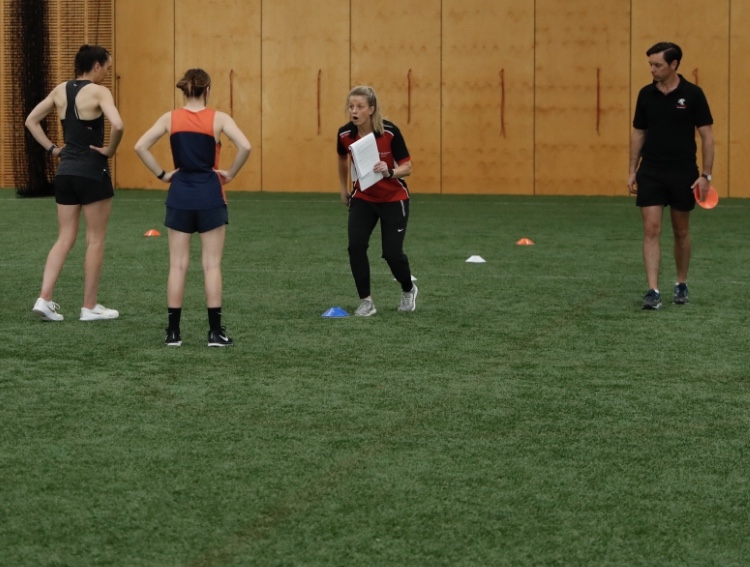In the latest instalment of “Mick Talks With….”, I sit down and talk shop about ACL injuries with ACL expert, Brooke Patterson. For those of you who don’t know Brooke, she has published and presented research on ACL injuries here in Australia and internationally. Giving herself some serious street cred, Brooke has also injured her ACL and knows exactly what it’s like going through ACL reconstruction rehab. She is also a player in the AFL Women’s competition, a code that has seen its fair share of ACL injuries in its first 2 seasons, and is doing her best at promoting injury prevention practices within the code. So without further ado, here is our conversation! I hope you all enjoy reading this one, as much as I enjoyed listening to Brooke share her wealth of knowledge..
Mick: So what got you interested in ACL research Brooke? Was previously injuring your ACL a big reason behind it?
Brooke: I think so. I actually had a big interest in it when I was a physio student. In my last 2 years of physiotherapy studies, I was lucky enough to be supervised by Kate Webster in an honours project on ACL injury. Halfway through the project, I did my ACL! My interest in ACL injury grew; from experiencing first hand, as an athlete, how difficult it was to recover physically and mentally from ACL injury, and the subsequent injuries that often occur
I'm really passionate about ACL injury and feel that there's a lot of room for improvement in the knowledge we currently have in this space, and want to be part of growing this current body of knowledge.
Mick: That's really good to get the background story Brooke! That's really interesting seeing it from your point of view. So you mentioned that you are doing research in the area of ACL's; can you give the readers a summary of what you've previously published, and what you're currently working on?
Brooke: My honours project was in ACL injury and the main finding was that there were postural control deficits in ACL reconstructed people compared to non-injured, age-matched controls. We also looked at postural control in ACL reconstructed patients with the addition of a cognitive task, and comparing whether or not adding a cognitive task affected postural control - which it did.
I'm now doing a PhD which is looking to identify risk factors for people that may end up with a poor outcome in the first few years after reconstruction.
Mick: Have you found any risk factors for a “poor outcome”?
Brooke: So the first paper of my PhD found that higher (>25 kg/m2) Body Mass Index (BMI) was a significant risk factor for worsening of joint features (eg. cartilage, bone marrow lesions and meniscus lesions). And that ACLR patients demonstrate an accelerated rate of degeneration, in particular, in the patellofemoral joint, compared to rates of degeneration in the general population.
We know from a lot of other research ACL-injured patients are at a greater risk of being overweight compared to their peers. So that was really nice for me to see in this population, and allows clinicians to be confident in saying to their patients that the consequences of weight gain and osteoarthritis do not just occur 10-15 years down the track. Poor outcomes and worsening structural changes actually can occur soon after the initial injury, and increased weight is a significant risk factor for degenerative changes.
Looking to the future, we need to look at more modifiable factors that may influence outcomes. There’s currently research from my supervisor Adam Culvenor in our cohort, which reports poor knee function at 1-year post-ACLR (e.g.
As a side note: Adam Culvenor, who published the research on the quality of life at 3years follow-up, he's also shown that, if you return to sport less than ten months post-op plus combined with having poor function, it increases your risk of having bone marrow lesions at 1-year.

Mick: So you've also got an interest in ACL prevention. What's the literature currently telling us about ACL injury prevention programs, in terms of reducing injuries, and what are the key components of a successful program?
Brooke: So there's a lot of strong literature around ACL injury prevention. Recently, there was a meta-analysis of meta-analyses - so you can't really get much stronger evidence than that – that reported ACL injury prevention programs reduce all types of ACL injuries by 50%. This research also showed that ACL injury prevention programs can decrease non-contact ACL injuries in females by 67%.
In regards to what are the key components? At the moment we don't really know what component of these evidence based programs is having the greatest effect. And it's likely that it's probably a combination of things that include some lower limb strengthening, core strengthening, balance/proprioception and movement drills that looks at jumping and landing and changes of direction.
Then there's the big picture things that we often forget about which are sometimes under-rated: ie. your general health and well-being, recovery practices, sleeping, eating, hydration, sport-specific skills and load management. All of these things play a role and should form part of the education of an injury reduction program. These aspects are historically hard to measure, monitor and implement, and the current evidence is very much focused on that 10-15 minute warm-up prior to training and games.
Mick: Excellent points Brooke! So despite the solid evidence of the success of those injury prevention programs, not all clubs, coaches, and players adopt them right? So what are these barriers as to why some coaches, clubs, and players aren't adopting these programs?
Brooke: There's definitely plenty of barriers in the real-world situation. I guess it's all great when there's a research trial, and you're getting monitored, and there might be external motivation to do the program, but as soon as that stops we know there's low uptake of the injury reduction programs.
Alex Donaldson and colleagues have done a lot research into why that is. One reason is that coaches don't know if they have the knowledge or skills to implement the programs without the support of research or allied health staff.
Research has also shown us that some coaches don’t believe that the program is related to their sport or they have the time to allocate the activities into their program. So, if we're talking about football, they don't believe the exercises in the injury prevention program are helpful or related to football. Combine that with the fact that their time at training is often limited, they don't want to spend 15 minutes doing these warm up exercises and strengthening exercises when they've only got an hour with their athletes.
Mick: Is there anything that can be done to overcome these barriers?
Brooke: Design of programs needs inclusion of education to rationalise why things like jumping and landing technique, change of direction technique will also improve football performance – i.e. studies have shown these programs improve vertical jump, speed and agility testing. The design and implementation of a program should also consider the sport specific skills (i.e. evading or tackling) the activities (i.e. change of direction) relate to and incorporate them into the warm-up. Programs should also be concept based, not prescriptive, so coaches can adapt them to their setting, in fun and creative ways.
Mick: Now even when there is successful implementation of ACL injury prevention programs, injuries can still occur, and I think that that's a big thing that people need to understand. Are there certain groups that are more likely to get injured despite the program being there in the first place?
Brooke: So if we're talking about groups of people that are specifically at a higher risk of sustaining an ACL injury, we know the biggest risk factor is “exposure”, especially in high risk sports. So here in Australia our high risk sports are netball, AFL and soccer, and you’re more likely to tear your ACL if you're participating in those sports. However, the relative risk is low, and we know the benefits of participating in sport far outweigh the risks or consequences of injury.
Research has also shown that the rate of ACL injuries are are going up in 10-14year old kids, and that kids that are more likely to sustain an ACL injury are less physically active than their peers.
The other known subgroup of higher risk is being female; largely due to the anatomical and biomechanical differences that don’t favour the female athlete. Also if you have a previous history, or family history the risk is increased. Approximately one in three under the age of 25 will sustain a second ACL injury (either limb) in the first 2-years following an ACL injury.
Mick: You're a player in the AFL Women's competition, a code that unfortunately has a well-publicised ACL problem. Do you have any insight as to why there's been such a large number of ACL injuries that have occurred in the first 2 years of its competition?
Brooke: The recent data that came out suggests that AFL women have a 9x greater risk of sustaining an ACL injury in a game compared to the men when they've accounted for exposure (i.e. shorter season). This is high compared to other female sports previous research will show that females are 2-5x more likely to sustain an ACL injury compared to their male counterparts. I think it'll gradually regress down a little bit over the upcoming seasons as we have a relatively small sample size of two 8-week seasons.
The AFL Women’s competition is also a relatively new sport for most of the athletes. Even though they've been playing other high-risk sports (e.g. netball, soccer etc) and coming across to AFL. It’s also a very unique sport in that it’s 360 degrees in nature, and very unpredictable.
Also it’s a newly formed professional competition, and the athletes have not previously been in elite pathways for football, or even in elite pathways in other sports. So I think there's a lot of different factors at play, and we need to focus on the things we can control – targeted female, sport specific strength, conditioning and movement training, and player wellness. And continue to investigate mechanisms and risk factors for injury, return to sport criteria for high risk athletes, and reinjury. I think that it will be interesting to observe the rates of ACL injuries over the next few years, as the community level and elite level competitions continue to grow.

Mick: So, when an injury unfortunately does occur, where does the current evidence sit in regards to surgery vs conservative management of ACL injuries?
Brooke: The Scandinavian's are leading the charge in terms of research in this space and, there's been a few good studies. One high quality study showed that the differences between having surgery or not are actually similar in terms of patient’s symptoms, function and quality of life at 2- and 5-years following injury. They also showed that rates of osteoarthritis, and patients returning back to their pre-injury sport (including pivoting and change of direction sports) are similar. The problem is that we can’t yet predict very well who can cope, and who can't cope, with this nonsurgical management.
What I think is a bit of a concern in this space is that some people are not giving themselves enough time to give non-surgical management a chance; 4-6 weeks of high-quality rehab might be good for some, but others may need a little bit longer to see if they're going to cope or not. I’ve got concerns over the current trend that if you’re not doing so well after 4-6 weeks, you're recommended surgery.
Mick: So what about those that do elect to have reconstruction? How important is it to have high quality rehab, and what would be the key components of a “high quality rehab”?
Brooke: The current evidence suggests that, at least 9-12 months of rehabilitation is essential. But as you know, we are trying to move away from time-based periods of rehab. Achieving goals and passing criteria as one moves through rehabilitation and eventually passing key performance tests prior to returning back to sport are the current recommendations.
One big thing to understand about passing return to sport tests though, is that I feel that the magnitude of performance tests needs to be considered. For example, if you’re a 26 year old male and you hop 30cm on each leg for your return to sport test (giving you 100% limb symmetry), that's not very good for a 26 year old male who wants to go back to football. So I feel that its important that we draw upon normative data or what the hop distance of the uninjured side was prior to the ACL reconstruction to get an idea of what the person’s previous best is/was, and that we get them back to at least that previous level of function. If not better!
Then the other thing that research will show is that supervised physiotherapy is really important, for at least the first 6 post-op months, with this research showing that ACLR patients have better strength and functional performance than those that don’t attend supervised rehab for as long.
Mick: Excellent facts Brooke! Now lastly, from your own experience of ACL injury, and certainly with your experiences from getting into ACL research, can you give any advice to anyone that has injured their ACL?
Brooke: Yes – seek expert opinion for your rehabilitation, and COMPLETE your rehabilitation! Even though I was studying physio, I thought I knew what I was doing. And there's probably a lot of people out there who are sporty and feel like once they can run go to the gym, then you're sweet - off you go, and you don't see your physio anymore. This is not what should happen!
So, I would definitely advocate for continuing to touch base with your physio, because there's a lot more to the rehab than getting new exercises all the time. You might not be here getting brand new exercises every time you see your physio, but checking in to see regularly what your quality of movement is like and setting new goals for the return to sport pathway is really important.
My other piece of advice is regarding whether or not to have surgery, and whether or not to go back to sport (and when) – and that is to have a lot of different conversations with different people. Your physio is going to be biased, your surgeon is going be biased, your family, your coach. All those people are going to have their own opinions, but I think it is important to get all those opinions and put them all together to make the best decision for you.
Mick: Very good, that's great insight and excellent advice thanks Brooke! That's all I've got for today. I appreciate your time and all your expert opinion on this one.
To keep up to date with great articles like this one, please consider joining our Learn.Physio mailing list.
Brooke's Masterclasse
Did you enjoy reading Mick's interview with Dr Brooke Paterson? Enrol in our 'Non-Operative ACL Masterclass' and watch her discuss this topic with Dr Adam Culvenor and Learn.Physio co-founders Randall Cooper and Mick Hughes:




